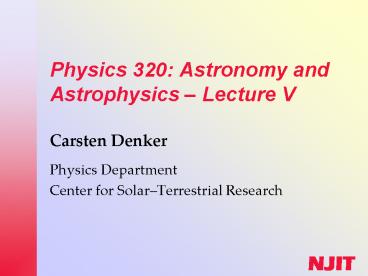Physics 320: Astronomy and Astrophysics - PowerPoint PPT Presentation
1 / 23
Title:
Physics 320: Astronomy and Astrophysics
Description:
NJIT Center for Solar-Terrestrial Research. The Interaction of Light and Matter ... Lyman. m = 1. Planetary model of the hydrogen atom? October 1st, 2003 ... – PowerPoint PPT presentation
Number of Views:31
Avg rating:3.0/5.0
Title: Physics 320: Astronomy and Astrophysics
1
Physics 320 Astronomy and Astrophysics Lecture
V
- Carsten Denker
- Physics Department
- Center for SolarTerrestrial Research
2
The Interaction of Light and Matter
- Spectral Lines
- Photons
- The Bohr Model of the Atom
- Quantum Mechanics and WaveParticle Duality
3
Electromagnetic Spectrum
4
Spectral Lines
- Auguste Comte 1835 in Positive Philosophy We see
how we may determine their forms their distances,
their bulk, their motions, but we can never know
anything of their chemical or minerological
structure. - William Wollaston, Joseph Fraunhofer, Robert
Bunsen, Gustav Kirchhoff, ? spectroscopy
5
Kirchhoffs Laws
- A hot (lt 0 K), dense gas or solid object produces
produces a continuous spectrum with no dark
spectral lines. - A hot, diffuse gas produces bright spectral lines
(emission lines). - A cool, diffuse gas in front of a source of a
continuous spectrum produces dark spectral lines
(absorption lines) in the continuous spectrum.
6
Spectroscopy
- Prisms
- Diffraction gratings
- Transmission grating
- Reflection grating
7
Photoelectric Effect
8
Compton Effect
In a collision between a photon and an electron
initially at rest, both the (relativistic)
momentum and energy are conserved.
9
The Bohr Model of the Atom
- Waveparticle duality of light
- Rutherford 1911 ? ? Au It was quite the most
incredible event that ever happened to me in my
life. It was almost as incredible as if you fired
a 15inch shell at a piece of tissue paper and it
came back an hit you. ? discovery of a minute,
massive, positively charged atomic nucleus - Proton mp 1836 ? me
10
Group AssignmentProblem 5.7
- Verify that the units of Plancks constant are
the units of angular momentum!
11
Hydrogen Atom
Planetary model of the hydrogen atom?
m 1 UV 122, 103, 97, nm Lyman
m 2 Visible 656, 486, 434, nm Balmer
m 3 IR 1875, 1282, 1094, nm Paschen
m 4 IR 4051, 2625, 2165, nm Brackett
m 5 IR 7458, 4652, nm Pfundt
12
Bohrs Postulates
- Only orbits are stable, where the angular
momentum of the electron is quantized L
nh/2?nh, and will not radiate in spite of the
electrons acceleration. - Every allowed orbit corresponds to a distinct
energy level and the transition from a distant
orbit to an orbit closer to the nucleus Ephoton
Ehigh Elow results in the emission of an energy
quantum, i. e., a photon.
13
Bohr Atom
14
(No Transcript)
15
Bohr Atom (cont.)
16
Kirchhoffs Laws Revisited
- A hot, dense gas or hot solid object produces a
continuous spectrum with no dark spectral lines.
This is the continuous spectrum of black body
radiation, described by the Planck functions
B?(T) and B?(T), emitted at any
temperature above
absolute zero. The
wavelength ?max
at
which the Planck
function B?(T) obtains
its maximum
is given
by Wiens
displacement law.
17
Kirchhoffs Laws Revisited (cont.)
- A hot, diffuse gas produces bright emission
lines. Emission lines are produced when an
electron makes a downward transition from a
higher to a lower orbit. The energy lost by the
electron is carried away by the photon. - A cool, diffuse gas in front of a source of
continuous spectrum produces dark absorption
lines in the continuous spectrum. Absorption
lines are produced when an
electron
makes a transition from a lower
to a
higher orbit. If the incident photon in
the continuous spectrum has exactly the
right
amount of energy, equal to the
difference in
energy between a higher
orbit and the
electrons initial orbit, the
photon is
absorbed by the atom and the
electron makes an upward transition to
the higher
orbit.
18
Quantum Mechanics and
WaveParticle Duality
19
Problem 4.5
20
Problem 4.13
21
Problem 4.18
22
Homework Class Project
- Prepare a 200 250 word abstract for one of the
five topics mentioned in the storyline - Important scientific facts
- Form of presentation
- Learning goals
- Homework is due Wednesday October 8th, 2003 at
the beginning of the lecture! - Exhibition name competition!
23
Homework
- Homework is due Wednesday October 8th, 2003 at
the beginning of the lecture! - Homework assignment Problems 5.4, 5.5, and 5.15
- Late homework receives only half the credit!
- The homework is group homework!
- Homework should be handed in as a text document!































